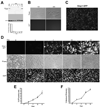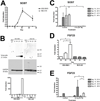Cell line IDG-SW3 replicates osteoblast-to-late-osteocyte differentiation in vitro and accelerates bone formation in vivo
- PMID: 21735478
- PMCID: PMC3192242
- DOI: 10.1002/jbmr.465
Cell line IDG-SW3 replicates osteoblast-to-late-osteocyte differentiation in vitro and accelerates bone formation in vivo
Abstract
Osteocytes are the most abundant cells in bone yet are the most challenging to study because they are embedded in a mineralized matrix. We generated a clonal cell line called IDG-SW3 (for Immortomouse/Dmp1-GFP-SW3) from long-bone chips from mice carrying a Dmp1 promoter driving GFP crossed with the Immortomouse, which expresses a thermolabile SV40 large T antigen regulated by interferon γ (IFN-γ). Cells from these mice can be expanded at 33 °C in the presence of IFN-γ and then allowed to resume their original phenotype at 37 °C in the absence of IFN-γ. IDG-SW3 cells are Dmp1-GFP(-) and T antigen(+) under immortalizing conditions but Dmp1-GFP(+) and T antigen(-) under osteogenic conditions. Like osteoblasts, they express alkaline phosphatase and produce and mineralize a type 1 collagen matrix containing calcospherulites. Like early osteocytes, they express E11/gp38, Dmp1, MEPE, and Phex. Like late osteocytes, they develop a dendritic morphology and express SOST/sclerostin and fibroblast growth factor 23 (FGF-23), regulated by parathyroid hormone (PTH) and 1,25-dihydroxyvitamin D(3). When cultured on 3D matrices, they express Dmp1-GFP and sclerostin. When the 3D cultures are implanted in calvarial defects in vivo, they accelerate bone healing. This cell line should prove useful for studying osteoblast-to-osteocyte transition, mechanisms for biomineralization, osteocyte function, and regulation of SOST/sclerostin and FGF-23.
Copyright © 2011 American Society for Bone and Mineral Research.
Conflict of interest statement
CONFLICT OF INTEREST
All authors have no conflicts of interest.
Figures







Similar articles
-
β-glycerophosphate, not low magnitude fluid shear stress, increases osteocytogenesis in the osteoblast-to-osteocyte cell line IDG-SW3.Connect Tissue Res. 2024 Jul;65(4):313-329. doi: 10.1080/03008207.2024.2375065. Epub 2024 Jul 10. Connect Tissue Res. 2024. PMID: 38982804 Free PMC article.
-
A Novel Osteogenic Cell Line That Differentiates Into GFP-Tagged Osteocytes and Forms Mineral With a Bone-Like Lacunocanalicular Structure.J Bone Miner Res. 2019 Jun;34(6):979-995. doi: 10.1002/jbmr.3720. Epub 2019 Jun 7. J Bone Miner Res. 2019. PMID: 30882939 Free PMC article.
-
Parathyroid Hormone Induces Bone Cell Motility and Loss of Mature Osteocyte Phenotype through L-Calcium Channel Dependent and Independent Mechanisms.PLoS One. 2015 May 5;10(5):e0125731. doi: 10.1371/journal.pone.0125731. eCollection 2015. PLoS One. 2015. PMID: 25942444 Free PMC article.
-
Regulation of bone-renal mineral and energy metabolism: the PHEX, FGF23, DMP1, MEPE ASARM pathway.Crit Rev Eukaryot Gene Expr. 2012;22(1):61-86. doi: 10.1615/critreveukargeneexpr.v22.i1.50. Crit Rev Eukaryot Gene Expr. 2012. PMID: 22339660 Free PMC article. Review.
-
Extracellular phosphate modulates the effect of 1α,25-dihydroxy vitamin D3 (1,25D) on osteocyte like cells.J Steroid Biochem Mol Biol. 2013 Jul;136:183-6. doi: 10.1016/j.jsbmb.2012.09.029. Epub 2012 Oct 9. J Steroid Biochem Mol Biol. 2013. PMID: 23064198 Review.
Cited by
-
FGF23 production by osteocytes.Pediatr Nephrol. 2013 Apr;28(4):563-8. doi: 10.1007/s00467-012-2309-3. Epub 2012 Sep 16. Pediatr Nephrol. 2013. PMID: 22983423 Free PMC article. Review.
-
Ex Vivo Organ Cultures as Models to Study Bone Biology.JBMR Plus. 2020 Feb 14;4(3):10.1002/jbm4.10345. doi: 10.1002/jbm4.10345. eCollection 2020 Mar. JBMR Plus. 2020. PMID: 32161838 Free PMC article. Review.
-
Oral cell lysates reduce osteoclastogenesis in murine bone marrow cultures.Cytotechnology. 2025 Feb;77(1):39. doi: 10.1007/s10616-024-00688-1. Epub 2025 Jan 8. Cytotechnology. 2025. PMID: 39781111 Free PMC article.
-
β-glycerophosphate, not low magnitude fluid shear stress, increases osteocytogenesis in the osteoblast-to-osteocyte cell line IDG-SW3.Connect Tissue Res. 2024 Jul;65(4):313-329. doi: 10.1080/03008207.2024.2375065. Epub 2024 Jul 10. Connect Tissue Res. 2024. PMID: 38982804 Free PMC article.
-
Vitamin a is a negative regulator of osteoblast mineralization.PLoS One. 2013 Dec 10;8(12):e82388. doi: 10.1371/journal.pone.0082388. eCollection 2013. PLoS One. 2013. PMID: 24340023 Free PMC article.
References
-
- Robling AG, Bellido T, Turner CH. Mechanical stimulation in vivo reduces osteocyte expression of sclerostin. J Musculoskelet Neuronal Interact. 2006;6(4):354. - PubMed
-
- Gluhak-Heinrich J, Ye L, Bonewald LF, Feng JQ, MacDougall M, Harris SE, Pavlin D. Mechanical loading stimulates dentin matrix protein 1 (DMP1) expression in osteocytes in vivo. J Bone Miner Res. 2003;18(5):807–817. - PubMed
Publication types
MeSH terms
Substances
Grants and funding
LinkOut - more resources
Full Text Sources
Other Literature Sources
Research Materials

